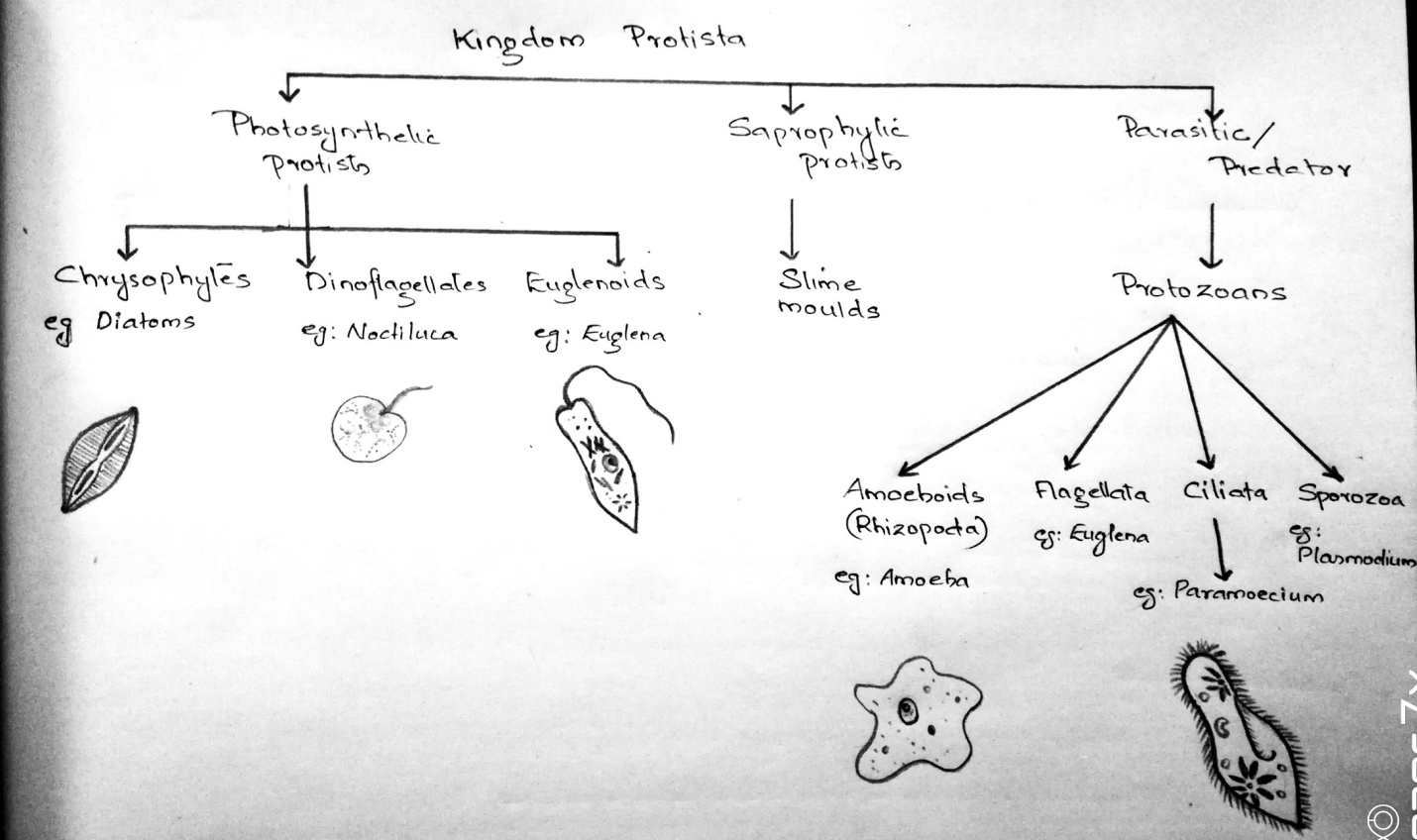All unicellular eukaryote were placed under the Kingdon Protista. Most of them live in aquatic habitats. Since they are eukaryotes, the cells have a distinct nucleus and membrane bound cell organelles. Motile protists possess either flagella or cilia. Reproduction involves both sexual and asexual methods.
Protista: Classification

Chrysophytes
Diatoms and Golden algae are the sole members of this group. They float on water surfaces and form a part of the phytoplanktons. They are very minute, and are found in both marine and freshwater habitats. Since they float on the surface of water, there is easy availability of sunlight, and hence most of them are photosynthetic.
Diatoms are called so because their cell wall forms as two halves, one fits with the other like a soap box. These shells contain silica, and thus are very strong and nearly indestructible. When the diatoms die, their shells are left behind in their habitat. These shells accumulate over billions of years to form large cell wall deposits known as diatomaceous earth. This earth or soil is grease – like, and are thus used for polishing and for the filtration of oils and syrups.
Dinoflagellates
Dinoflagellates are unicellular protists which exist in a variety of forms. The variation occurs mostly in the appearance. They can be yellow, green, brown, blue or red in colour, depending on the pigments found in the cells. Most of them are motile, and possess two flagella, and thus the name dinoflagellates. They are usually marine and photosynthetis. Some are capable of producing light through bioluminescence. Noctiluca, the largest dinoflagellate, can produce blue light at night.
The dinoflagellates are capable of creating very noticeable impacts in their surroundings. The red dinoflagellates, such as Gonyaulax, are coastal marine species. They reproduce in large numbers during the summer forming a ‘bloom’ and covers the coastal areas, making the sea appear in golden or red color. This is called a “red tide”. Certain marine dinoflagellates release a neurotoxin which can affect the muscle functions of fishes and shell fishes. Large amount of these toxins can kill the fishes also. Humans are indirectly affected by these toxins, through the consumption of fishes or shellfishes affected by the toxin. Eating poisoned fish results in a disease called Ciguatera, and eating shell fishes (clams, mussels, oysters) can cause PSP (Paralytic shellfish poisoning).
Euglenoids
Euglenoids are elongated protists. Their cells are covered by a protein – rich flexible coat calle pellicle, which makes them flexible and allows them to change their shape. They possess two flagella (one long and one short), which are used for swimming. They can also creep along a flat surface using a peculiar type of movement known as metaboly.
Most euglenoids are photosynthetic and appear green. Some lack chloroplasts and are colorless. They are usually found in shallow and stagnant freshwater habitats, but a few are found to live as parasites on animals. When photosynthetic dinoflagellates do not receive enough sunlight, they are capable of predating on small organisms.
Slime moulds
Slime moulds are saprophyte. They feed on dead organic matter. Under unfavourable conditions, they form fruiting bodies called sporangia. Clusters of spores are formed at the tip of sporangium, and are released for dispersion. The spores germinate at new habitats to form new individuals. Slime moulds are of three types.
Plasmodial slime moulds, are quite large in size and contain large number of nuclei. They are formed by the fusion of individual flagellate cells to form a giant cell with many diploid nuclei. Cellular slime moulds lives as individual amoeba – like cells. The third group is known as slime nets.
Protozoans
Protozoans are mostly predators or parasites. They exhibit most of the characters associated with animals, and are hence considered to be most primitive of all animal cells. They are categorized into four groups.
Amoeboid protozoans: the members are amoebae like. They are found in freshwater and marine habitats, and in soil. They form temporary extensions called pseudopodia for their movement. They engulf food by phagocytosis. Freshwater amoeboids include Arcella, Difflugia, Entamoeba histolytica etc.
Flagellated protozoans: These include uninucleate organisms, which possess one or more flagella for locomotion at some time of their life cycle. They are either free-living or parasitic. Trypanosoma is a parasitic flagellate that causes sleeping – sickness in humans.
Ciliated protozoans: they are found in almost every aquatic environment. The name is derived by the presence of dense, hair like structures called cilia, used for locomotion. The beating of cilia helps the organism to swim through water, and to draw in food particles too the mouth. Eg. Paramoecium, Vorticella etc.
Sporozoans: This group mostly contains parasitic protists. They have an infectious spore like stage in their life cycle. Members of this group cause malaria and toxoplasmosis. Malaria is caused by Plasmodium vivax.